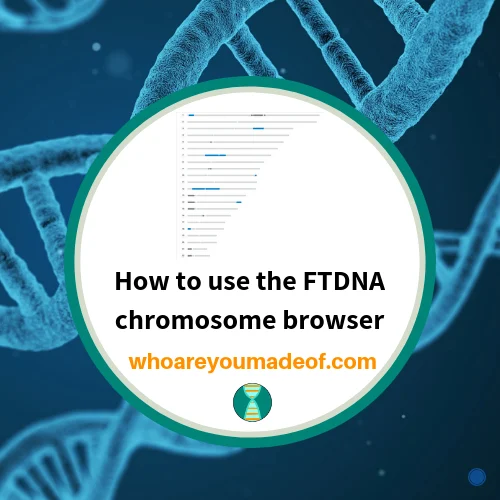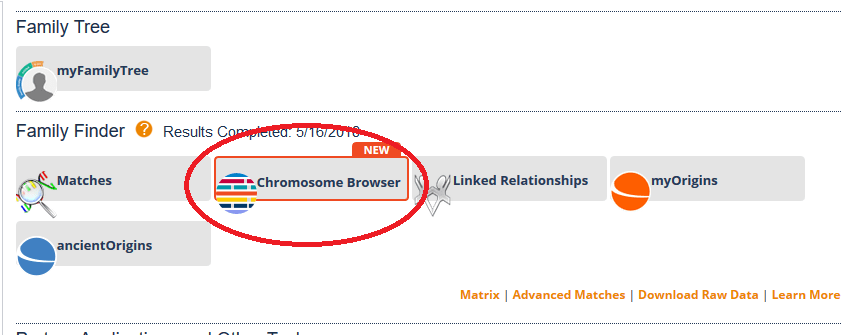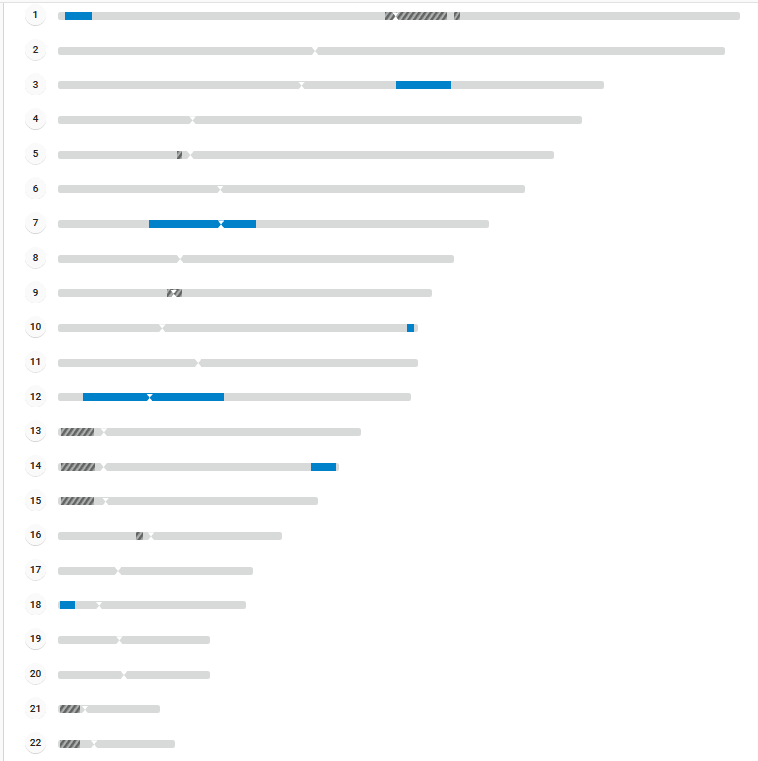Have you ever wondered what the Family Tree DNA Chromosome Browser is and how it can help you? In this post, I will explain how to use this very cool tool, and what type of helpful information you can learn, and how it can be useful for your family tree research.
FTDNA has recently released an updated version of their browser, and this post is based on the new version.

While the information in this post is specific to the Family Tree DNA chromosome browser, it will be helpful to you no matter which website you are using to browser chromosomes.
And if you aren't using Family Tree DNA, why not start now? It's free to upload your DNA to the site to get DNA matches, and you only have to pay $19 if you want full access to all features, including the chromosome browser. It's a great way to "stretch" your DNA dollars - learn more in my post about how to upload to Family Tree DNA.
What is a chromosome browser?
While it's cool to know that you and a particular DNA match are related and even how much total DNA you share with each other, there is very real utility in knowing exactly where your shared DNA segments are located on your individual chromosomes.
What!? Is this even possible? While it sounds like something out of a science fiction film, or something that us "regular people" would never be able to understand, it's actually true.
We all have 22 numbered chromosomes and one sex chromosome, and we can use a chromosome browser to compare our chromosomes to those of our DNA matches to spot exactly where we match and where we don't.
If you have ever clicked on the chromosome browser out of curiosity and didn't really understand what you were looking at, don't worry. Keep reading and I'll help you figure it all out 🙂
How to access the Family Tree DNA Chromosome Browser
If you are interested in seeing what you might be able to learn from the Family Tree DNA Chromosome Browser, there are two ways to access it. The first way is from your main DNA results dashboard, which you should see upon logging in to your Family Tree DNA account.
In the image below, you can see the link to the chromosome browser circled in red:

The other way to access the Family Tree DNA chromosome browser is from within your DNA match list. You can select up to seven DNA matches by checking the little box to the left of their names on your list.
Once you have selected the DNA matches that you would like to compare on the chromosome browser, you can click the "Chromosome Browser" option above the DNA match list. This is my favorite way to access the browser because I can select the matches that I am interested in directly from my list - instead of having to remember who they are in the chromosome browser:

How to understand the FTDNA Chromosome Browser results
Okay, cool. You know how to access the browser, but what do the results mean?
When you choose a DNA match to view in the chromosome browser, you will see a screen showing all 22 of your numbered chromosomes and your X chromosome. Any shared DNA segments will show up on this screen, and will look something like this:

As you can see the from the image above, I share several DNA segments with my mom's second cousin. We share seven DNA segments that are larger than 5 cM in length, and the browser tells me exactly which segments we share that fit this criteria.
The chromosome browser is telling me that my cousin and I share segments with my cousin on Chromosomes 1, 3, 7, 10, 12,14, and 18. The location and size of each segment is shown visually, but I can also hover over any given segment to see the exact size of the segment, as well as the specific start and stop locations for the segment:

If I want to, I can adjust the threshold and request to only see segments larger than 1, 5, 7, or 10 cMs. This option is available above the chromosomes, next to where it says "Detailed Segment Data":

There are unique benefits in viewing all of the DNA segments that are larger than 10 cM in length. One such benefit, for example, is being more confident that the shared DNA segment is valid.
In other words, you can be more confident that a larger segment is identical-by-descent instead of identical-by-state (i.e. coincidentally identical). The more confident that you are that a segment is legitimate, the more confident you can be that the segment can be attributed to a common ancestor (see below).
Special note about the FTDNA chromosome browser and the X chromosome
If you notice that you have a shared DNA segment on the X chromosome, and you are male, then you can assume that your X DNA match is on your mother's side of the family. This is because males only inherit X DNA from their mothers.
Females cannot come to any conclusion so easily, however, since we inherit X DNA from both our mother and father.
The size of the segment can be interpreted similarly like with segments on other chromosomes. Larger segments generally mean a more recent ancestor and smaller segments generally mean a more distant common ancestor.
What do we do with the information that we learn in the Family Tree DNA chromosome browser?
The most important use for chromosome browser information is to help us figure out how we might be (or are) related to our DNA matches.
For example, if I know that I share great-great grandparents with a particular DNA match on my mom's side of the family, then I can probably assume that the shared DNA segments shown on the chromosome browser were passed down to me (and to my DNA match) from those shared ancestors.
The next bit of logic that can be applied is that other people who match me on those same DNA segments on the same chromosomes (or segments that overlap with those segments) are also descended from the same common ancestor.
Take for example the following image. It is a comparison of DNA shared between a half-second cousin once-removed and myself. His great-grandfather is my great-greatgrandfather on my mom's side of the family.
Since we only share one most recent common ancestor, I can be fairly sure that the DNA segments that we share in common were passed down from that particular great-great grandfather to me. We share three segments, but the largest is 30.38 cMs on Chromosome 7:

Before we get too in-depth with discussing specific Family Tree DNA chromosome browser results, it is important to note that even though we only have 22 numbered chromosomes, we actually have TWO copies of each chromosome.
One copy was inherited from our mother, and the other copy was inherited from our father. Without careful examination, it's impossible to know which copy came from which parent, and it can also vary from chromosome to chromosome (i.e. copy 1 on Chromosome 2 can be from dad, and copy 1 on Chromosome 3 can be from mom).
This means that in order to know which copy of the chromosome your DNA match matches you on, you will need to know if they are on your maternal or paternal side of your family.
This is because if you know that your DNA match is on your dad's side of the family, it's most likely that the copy of the chromosome that you match on is the paternal copy, and vice versa.
It's always possible that we are related to our DNA matches in more than one way (i.e. on both our mom and dad's lines, even if they aren't related to each other), which is just something to keep in mind.
Referring once again to my match with my half-second cousin, I now know that if I have another DNA match who is on my maternal side (i.e. matches my mom) who also matches me at the same genomic position on Chromosome 7, we are either both descended from the same person (i.e. my great-great grandfather) or we are both descended from someone who is an ancestor of my great-great grandfather (i.e. someone who is further back in my tree than my great-great grandfather).
Tip: In order to keep track of your shared DNA segments and information learned using chromosome browsers (including this browser from FTDNA), why not use DNA Painter? It's a really cool way to visualize which ancestors passed down which DNA segments to you and will help you learn more about your family tree.
DNA segment triangulation and the Family Tree DNA chromosome browser
Something else that you can do with the chromosome browser is learn how to triangulate DNA segments among you and at least two DNA matches in order to identify groups of matches who appear to be descended from the same known or unknown ancestor.
You can take note of triangulation groups by noticing patterns (i.e. a group of people that all seem to match you on the same segment), or by using the chromosome browser to compare multiple people at once.
You can select multiple people from within your DNA match list, or you can select your DNA matches you'd like to compare from within your chromosome browser. It's most helpful to select groups of people that you know are related to you on the same side of your family, or that you think (for whatever reason) might be related to you on a particular line of your family tree.
For example, take a look at the following image:

To show you how triangulation works, I chose four DNA matches that I thought might be related on the same lines of my mom's family. They are my DNA matches, but they also share my mother in common.
The segment that you see in orange (at the bottom of the image) is a segment that I share with my mom's second cousin ("Jane") on her Slovak line. This line interests me, so I chose a few other matches that I thought might also match on this line.
I was wrong about two of the matches (oops - it turns out that our assumptions aren't always right), but one of the women does match me on the same segment that my Slovak cousin matches me on.
This likely means that the cousin that you see in magenta ("Sandy"), "Jane", and myself, are all descended from my the great-great grandparents that I share with Jane, or ancestors further back in my Slovak lines (i.e ancestors of my Slovak great-great grandparents).
Conclusion
I hope that this post gave you some ideas about how the Family Tree DNA chromosome browser information can be useful to you, how to use it, and what to do with the information that you learn. If you have any questions about something that you read here, or would like to share your experience with the chromosome browser, I would love to hear from you in the discussion below.
Thanks for stopping by!

